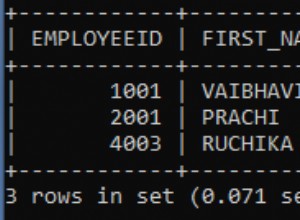PostgreSQL dalla versione 9.5 ha la sintassi UPSERT, con clausola ON CONFLICT. con la seguente sintassi (simile a MySQL)
INSERT INTO the_table (id, column_1, column_2)
VALUES (1, 'A', 'X'), (2, 'B', 'Y'), (3, 'C', 'Z')
ON CONFLICT (id) DO UPDATE
SET column_1 = excluded.column_1,
column_2 = excluded.column_2;
La ricerca di "upsert" negli archivi del gruppo di posta elettronica di postgresql porta a trovare un esempio di come fare ciò che potresti voler fare, nel manuale:
Esempio 38-2. Eccezioni con UPDATE/INSERT
Questo esempio utilizza la gestione delle eccezioni per eseguire UPDATE o INSERT, a seconda dei casi:
CREATE TABLE db (a INT PRIMARY KEY, b TEXT);
CREATE FUNCTION merge_db(key INT, data TEXT) RETURNS VOID AS
$$
BEGIN
LOOP
-- first try to update the key
-- note that "a" must be unique
UPDATE db SET b = data WHERE a = key;
IF found THEN
RETURN;
END IF;
-- not there, so try to insert the key
-- if someone else inserts the same key concurrently,
-- we could get a unique-key failure
BEGIN
INSERT INTO db(a,b) VALUES (key, data);
RETURN;
EXCEPTION WHEN unique_violation THEN
-- do nothing, and loop to try the UPDATE again
END;
END LOOP;
END;
$$
LANGUAGE plpgsql;
SELECT merge_db(1, 'david');
SELECT merge_db(1, 'dennis');
C'è forse un esempio di come farlo in blocco, utilizzando CTE in 9.1 e versioni successive, nella mailing list degli hacker:
WITH foos AS (SELECT (UNNEST(%foo[])).*)
updated as (UPDATE foo SET foo.a = foos.a ... RETURNING foo.id)
INSERT INTO foo SELECT foos.* FROM foos LEFT JOIN updated USING(id)
WHERE updated.id IS NULL;
Vedi la risposta di a_horse_with_no_name per un esempio più chiaro.




